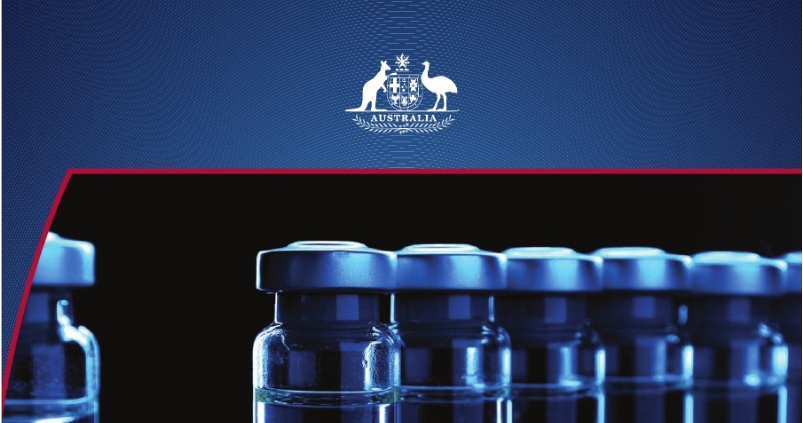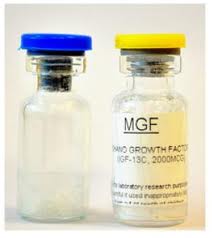What’s new about the mechano growth factor
At the start of the year 2014 this news dominated the broadcasting about the Wintergames in Sotsji Russia.
Full Size MGF – New Doping Substance from Russia
I posted about MGF earlier here: //www.juicedmuscle.com/jmblog/content/mgf-mechano-growth-factor
 The most credible German TV station (ARD, 02.02.2014) revealed with an undercover journalist that some well-known Russian biology professor/scientist (they do not mention his name) is selling a new doping substance called "Full Size MGF".
The most credible German TV station (ARD, 02.02.2014) revealed with an undercover journalist that some well-known Russian biology professor/scientist (they do not mention his name) is selling a new doping substance called "Full Size MGF".
The undercover journalists got 1 milligram of the drug “Full Size MGF”, to test it.
For 100,000 euro the rogue scientist , working at the Russian Academy of Sciences in Moscow , could provide an amount (100 mg ) that athletes could use for the Winter Olympics in Sochi . The ideal time to take the product would be 2 or 3 days before a contest
They gave the "Full Size MGF" to the IOC/WADA Anti-Doping Laboratory in Cologne. According to the IOC/WADA laboratory, "Full Size MGF" acts like IGF-1, but much stronger and they also stated that they have never heard of it before and that they of course don't have any test for it. . David Howman,
Director General of the World Anti- Doping Agency , WADA , was therefore shocked when he saw the WDR report . "It would be naive to believe that they are all athletes who will participate in Sochi are pure. " The IOC doping testing plant in 2453 in Sochi , the highest ever number of doping tests at the Games .
The most interesting part is, that this Russian biology professor/scientist is apparently selling MGF since 2010! That means the IOC/WADA might be 3-4 years late!
Is this new??
Of course NOT, in April 2013 this headline appeared on the news and the web:
Doping probe rocks Australian sport !

For some reason in some parts of the world, certain drugs or peptides are more popular than in other parts or countries. See the picture on the right that shows google searches to certain drugs.
Australian athletes have been turning to a "new generation" of banned substances to get the edge over their opponents, according to today's Australian Crime Commission report.
The report says hormones and peptides, such as growth hormone releasing hexapeptide (GHRP), are being used by athletes across Australia's major codes.
"Peptides and hormones are considered a new generation of substances and most are prohibited in sport," Australian Sports Anti-Doping Authority chief Aurora Andruska said. "In many instances, the substances are not yet approved for human use."
"These are very serious performance enhancing drugs and at the moment they're very hard to detect through testing so at the moment the only way to determine that athletes are using them is through coercive powers," he said today.

Scientific research is continuing. They find new purposes for MGF as a neuroprotectant in brain and heart ischemia etc see underneath. But all these scientists need to talk to ethical commisions and have to find sponsors to finance the research and they need participants (in vivo) in their studies, but mostly this will be denied, thus they have to work with animals or muscle tissues (in vitro) which impairs the results
Bodybuilders don’t have those limitations, they can inject what and whatever and where they think it will work. They discuss and share their experiences with other bodybuilders and often come with better results than the scientists. Peter Sonkson an emeritus (retired) Professor of Endocrinology acknowledged it and I posted about it here: //juicedmuscle.com/jmblog/content/famous-professor-gives-his-refreshing-opinion-gh-bodybuilding
On the picture above you see some 60 ml vials filled with plain Synthol and some vials of Synthol enriched with PEGylated MGF. Just like official research, bodybuilders continue to find the right combinations timing, cycles and spots like subcutainously, IM, and in case of the picture locally (spotinjections) and in a depot of MCT oils.
.JPG)
On the label of these Pegylated MGF you see that they are stabilised, next to the PEGylation this means the 24 amino acid sequence was modified, the precise amino acid sequence of this PEG-MGF is :
PEG-Suc-YQPPSTNKNTKSQ(d)R(d)RKGSTFEEHK-NH2 and the natural L-Arginines are replaced by D-form Arginines, and the position 23 is replaced by an Histidine. Why? Geoffrey Goldspink patented his invention (WO 2006/097764 A1). This patent discloses the precise stabilization and it isn’t too hard to find a reliable manufacturer if you have the right contacts.
What is very difficult for bodybuilders that want to buy peptides, is where to buy, everybody promises great quality for less, but what do they really inject? This is true for all illegal substances. Also for UG anabolic steroids. Most people will settle for underdosed and or polluted means as long as it really contains some active ingredient, but often they are just scammed. No wonder some users report on the boards disappointing results
Mechano-Growth Factor: an important cog or a loose screw in the repair machinery? Zablocka et all 2012:
Clearly more research is needed. But MGF seems to be a highly under-researched subject, particularly if one considers the likely applications of MGF in diseases with a great socioeconomic impact in aging populations (e.g., cardiovascular, sarcopenia, and neurodegeneration). This probably reflects the complexities of biopharmaceuticals development. These products, by the very nature of their origins face specific problems in terms of manufacture, storage, quantifiable standardization and, finally, their approval. This is usually associated with higher costs when compared with small molecule drugs. Industry often finds these costs unacceptable when facing possible patent right challenges based on slightly modified biosimilars and rapid emergence of market competition following patent expiry.
In an astonishing contrast, the MGF has been welcomed and widely accepted by the body building industry and numerous fitness enthusiasts. Body builders use this peptide alone or in combination with other anabolic compounds. Perfunctory survey of various discussion fora makes a chilling read for anybody who knows how little is yet known about the MGF. Detailed advice on administration regimes contains a mixture of in depth scrutiny of scientific literature and a hear-say following self-administration. Although its function is not fully understood and its efficacy in man is not proven, MGF is seen as a powerful tool to gain performance (Bachl et al., 2009). It is not surprising that the World Anti-Doping Agency has banned the use of MGF in sports. Recent study reporting MGF detection in two black market products (Esposito et al., 2012) clearly confirmed that MGF preparations are commercially available for use as doping. Even more ominously, illegal production of MGF mimetics and attempts to bypass the WADA ban may result in generation of analogs of unknown properties and potentially serious side effects.
Producing human mechano growth factor (MGF) in Escherichia coli. Kuznetsova et all 2008
A.N. Bakh Institute of Biochemistry, Russian Academy of Sciences, Leninskii prosp., 33, Moscow 119071, Russia.
Biological activity of refolded MGF was analyzed in vitro in proliferation assays with normal human myoblasts. As a result of our work, it has become possible to generate a standard MGF control with characterized activity and a ready-to use MGF test-system neither of which have been previously described. Our data open opportunities for the future works on MGF characterization and to the development of a powerful and highly specific therapeutic agent potentially applicable for muscle growth up-regulation, post-trauma muscle repair, age and hereditary myodystrophy mitigation and in sport medicine.
Growth factors, muscle function and doping, Goldspink et all 2008
“The fact that MGF 'kick starts' the hypertrophy process clearly has potential for abuse and has already attracted the attention of body builders”
Research on mechano growth factor: its potential for optimising physical training as well as misuse in doping. G Goldspink Br J Sports Med 2005
Let’s be realistic, the title covers it all!! But why should we talk about misuse or abuse. Why not be more open and optimistic. It’s not a recreational drug, these means maybe can be of use for older fragile or sick people. But maybe they can be used in athletic competition or physical and/or cosmetical improvements. We allow cosmetical surgery, the use of AAS and GH. I wouldn’t be surprised if MGF (actually a part of rhGH) could be prescribed in a few years.

An Australian Crime Commission investigation has found widespread drug use in Australian professional sport, with some athletes being given substances not yet approved for human use.
The year-long investigation says organised criminal networks have been involved in distributing the drugs to athletes and support staff, including doctors and coaches.In at least one case an entire team is believed to have been doped.
A former head of the Australian Sports Anti-Doping Authority says today is the "blackest day in Australian sport"
The Australian Crime Commission's report states:
Some peptide supplements are legal, and work similarly to protein supplements to help the body recover from strenuous activity.
However, there are also a variety of peptides that encourage the body to release growth hormones.
These type of peptides stimulate muscular growth with fewer side effects than anabolic steroids.
They are sold either as a cream or in a solution for injection.
The ACC report notes that various types of growth hormone releasing peptides, including hexapeptides like GHRP-2 and GHRP-6, are being used.
The report notes that these type of peptides are also used in combination with anabolic steroids to maintain muscle gains.
From an anti-doping perspective, the ability to detect the use of growth hormone releasing peptides is complex, as the substances are rapidly metabolised.
Growth hormone releasing peptides are prohibited by the World Anti-Doping Agency (WADA).
* Growth hormone variants
The ACC report identified the use of Australian-owned growth hormone variant AOD-9604 in sport.
The protein-based hormone helps burn fat and stimulates weight loss, though does not necessarily enhance muscle strength.
Clinical trials have suggested it also helps repair muscle and tissue after strenuous activity.
AOD-9604, used as a cream or injected in liquid form, is not prohibited by WADA but is also not approved for human use.
* Selective androgen receptor modulators
Naturally, testosterone binds to a cellular receptor called the androgen before travelling to the cell's nucleus.
Like anabolic steroids, SARMs work by stimulating the androgen receptor, boosting the uptake of testosterone into cells.
SARMs have similar effects to anabolic steroids - improving strength, bone density and muscle mass - but reportedly with fewer side-effects.
Anabolic steroids can cause acne, the development of male characteristics in females and baldness, infertility and breast tissue development in males.
The ACC report notes that the use of SARMs by elite athletes has been well documented since 2008.
SARMs, injected or used as a cream, are on WADA's prohibited list.
* Insulin-like growth factors
Insulin-like growth factors (IFG-1) are one of the primary hormones needed for cell growth.
They are produced in the liver and are similar to insulin.
They are known for their anabolic effects during childhood growth, but remain active into adulthood.
When tested on animals, IFG-1 was found to promote new cell growth and muscle repair, heal tendon injuries and produce rapid increases in muscle mass and strength.
While there are no scientific tests of its impact on humans, the hormone's anabolic effects are believed to increase muscle, aid recovery, reduce fat and boost endurance.
The ACC report says many players will use IGF-1 in small doses to reduce the chances of returning a positive anti-doping test.
IFG-1, which is injected in liquid form, is on WADA's prohibited list.
* Mechano growth factor
Mechano growth factor, which is injected in liquid form, is a variant of the IFG-1 hormone.
It is released naturally in response to muscle stretching and exercise, particularly weight training.
It stimulates stem cells to become part of the muscle tissue, and thus can produce fast increases in muscle mass and strength.
Mechano growth factor is on WADA's prohibited list, and it is illegal to possess the hormone without a prescription.
* Untested substances
The ACC report also identifies the use of a variety of substances that are not approved for human use. But how much do you know about the substances like GHRP, pig brain extract, and the other weapons in the dopers' chemical arsenal?
While not prohibited by WADA, their use is considered experimental and "off-label" because there is a lack of long-term clinical studies on the long-term impact of their use.
The substances include:
- Cerebrolysin: a peptide extract from pig brain which is used to treat Alzheimer's and stroke victims. It is said to improve cognitive and behavioural performance by enhancing the function of neurons.
- Actovegin: A filtered extract from amino-rich calf blood which leads to improved absorption of glucose and oxygen in tissue. It may enhance physical performance and stamina.
- AOD-9604: An anti-obesity drug which mimics the effects of exercise and is currently going through human clinical trials. The Australian-developed drug is designed to replicate the human growth hormone that controls the rate of fat metabolism.
- TA-65: A drug which acts on a section of the DNA and reportedly reduces ageing at the cellular level. It is said to work by targeting telomeres, which are sequences that protect the ends of chromosomes during DNA replication. Telomeres become shorter every time a cell divides, and TA-65 reportedly helps lengthen them, possibly slowing ageing
When Human Growth Hormone (GH) was first introduced to the bodybuilding world, everyone had high hopes. Those hopes fizzled out pretty quickly, as bodybuilders experimented with absurdly low dosages (2iu/every other day), necessitated by its high cost. As GH costs fell due to more efficient manufacturing processes (i.e. it was no longer being extracted from cadavers), bodybuilders were able to use more of it, and subsequently began to see better results. We saw the same phenomenon with the anabolic mediator of GH, Insulin-like Growth Factor-1, and later with its analogue, LR3IGF-1.
Now, we’ve seen the emergence of yet another compound further down the hormonal cascade: Mechano Growth Factor (MGH). As you probably know, skeletal muscle responds to resistance training (or any mechanical overload), by increasing its size (hopefully). If you ‘detrain’ that muscle (i.e. don’t use it regularly), it atrophies and gets smaller.
Similarly, when you are in your teens and early twenties GH and IGF-1 levels are high, and as you age, those levels are lowered naturally. And if you’ve been playing along at home, you’re probably figuring out that GH and IGF-1 are pieces of the hormonal puzzle that result in this muscle growth (or loss). These growth factors are produced in the liver and other areas, but also in skeletal tissue in response to training induced damage. Now, pay attention, because this is the important part - growth factors produced within the muscle as a response to resistance training likely play a major role in repair, adaptation, hypertrophy (muscle growth), and also ageing.
Scientists have discovered that many of GH’s anabolic and regenerative effects are actually mediated by insulin like growth factor 1. Thus, the next logical step for bodybuilders (if bodybuilders can be said to follow some kind of logic), was to start experimenting with IGF-1 and later with the more potent version, LR3IGF-1.
The thing is, we now know that IGF-1 actually exists in the body in multiple isoforms. The isoform that seems most useful to us, differs slightly from that which is produced in the liver (IGF-1Ea). It also appears to be the significantly more anabolic of the two we’re looking at here (i.e. that which is produced in the liver vs. that which is produced in the muscle). This is because it is hyper-sensitive to the signals produced by local muscular damage induced by resistance training. This more anabolic isoform of IGF-1 is called “IGF-1Ec” or mechano growth factor (MGF).
That’s right, MGF, the mysterious hormone that seems to be only whispered in e-mails and PMs on the net, is actually just another variant of IGF-1. Yeah, if you’ve used IGF-1 or even GH, then technically, you’ve already been taking advantage of MGF. In fact, if you work out with weights, you’ve been producing your own MGF - as this particular isoform of IGF-1 is only detected in normal muscle after mechanical stimulation (such as resistance training). Remember, MGF is just a name for the particular type of IGF-1 which is produced locally in the muscle as part of the anabolic repair response to resistance training.
Here’s how it happens…
When we work-out with weights, the IGF-1 gene is differentially spliced during the body’s response to local muscular overload. First it is spliced to produce predominantly IGF-1Ec (called the MGF splice variant of IGF-1). This initial splicing appears to stimulate satellite cells into activation. This in turn allows the activation of extra undamaged nuclei required for muscle fiber growth and repair to occur. In addition, the appearance of MGF initiates the upregulation of new protein synthesis. After this initial and short lived burst of splicing, IGF-1 production switches towards producing a systemic release of IGF-1Ea from the liver, which upregulates protein synthesis as well, but over a longer time line. This secondary release of IGF-1Ea noticeably less anabolic than the initial release of IGF-1Ec (MGF).
It is the expression of the various IGF-1 splice variants, over the course of the healing and regrowth phase of muscle repair, that is responsible for a generous portion of the body’s ability to engender growth in target tissue (which is, of course, skeletal muscle). It would appear that the introduction of this hormone, whether by weight training or by injection, will cause a response in the area resulting in localized muscle growth.
But, in the end, we’re still just talking about IGF-1, just a particular form of it…
As is often the case with the ‘hot new drug on the net’, the rabbit was always in the hat, and the magic was only a trick. MGF is simply a variant of something we’ve had around for over a decade. It’s just not as sexy when we call it “IGF-1Ec”, but regardless of what we call it, it’s still just an isoform of IGF-1. In fact, the anabolic actions of both IGF-1 as well as MGF are achieved by stimulating and up-regulating protein synthesis, and proliferating growth and activation of satellite cells. Actually, this latter function of MGF is quite important, as satellite cells are the mono-nucleated cells in muscle fibers located between the sarcolemma and the basal lamina. Proliferation and activation of these cells results in the creation of new muscle.
And all of this leads us to the real question here, which is: “How effective is this stuff?”
Well, most of what we have to go on presently is studies in the elderly (which there are very few of), and studies in rodents. The most relevant rodent data has been shown that MGF is a very potent inducer of muscle growth when it’s introduced into the muscle via an intramuscular injection. In fact, in one study MGF caused a 20% increase in the weight of the injected muscle within 2 weeks! Further investigation elucidated that this was actually due to an increase in the size of the muscle fibers!
 However, scientists are coming around to identifying the one-two-punch of MGF with regards to both inducing satellite cell activation as well as protein synthesis as clearly showing an advantage over other types of (systemic, or liver derived) IGF-1. In fact, when locally produced IGF-1 was compared to systemic IGF-1 (i.e. IGF-1Ea vs. IGF-1Ec) in later rodent studies, the superiority of the locally produced IGF-1 variants (MGF) were clearly elucidated.
However, scientists are coming around to identifying the one-two-punch of MGF with regards to both inducing satellite cell activation as well as protein synthesis as clearly showing an advantage over other types of (systemic, or liver derived) IGF-1. In fact, when locally produced IGF-1 was compared to systemic IGF-1 (i.e. IGF-1Ea vs. IGF-1Ec) in later rodent studies, the superiority of the locally produced IGF-1 variants (MGF) were clearly elucidated.
It may just be that overexpression of MGF (IGF-1Ec) and the subsequent overexpression of IGF-1Ea are the deciding factors in whether a muscle will grow or not. But remember what I told you at the beginning about GH and IGF-1 in general?
Until the prices on MGF go down to affordable levels, bodybuilders are probably going to be using substandard doses of MGF and reporting substandard results; or using tiny amounts with boatloads of other pharmaceuticals, and claiming absurd results. In the end, what we’re looking at is another variant of IGF-1, that’s probably going to be even better than LR3IGF-1 at producing muscle growth - once somebody finds a way to produce really good quality products at affordable prices.
- Login to post comments


